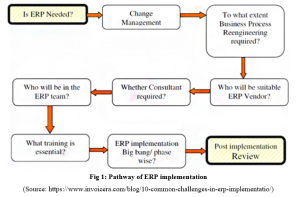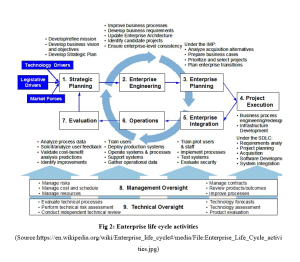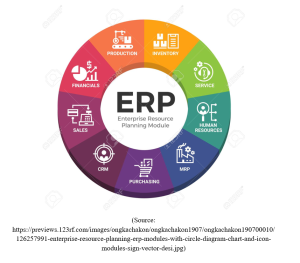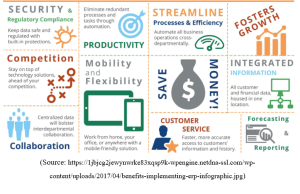BISY2005 Enterprise Systems Assignment Sample
Here’s the best sample of BISY2005 Enterprise Systems Assignment, written by the expert.
Introduction
“Enterprise Resource Management” (ERP) can be defined as a system or software that utilize resources of that enterprise or organization.ERP is semi-functional software that can manage all the business processes within the enterprise. An organization uses ERP system to manage and control their internal and external resources including financial and accounting, purchasing, selling of a product, inventory, sales and marketing, HR, customer relationship management and lastly supply chain management. An enterprise can make significant decisions by covering the information given by ERP. In today’s world ERP is essential for handling the business of all sizes and industries. Various companies like Woolworths Group Limited, Coles Group Limited follow the ERP module. `
Background of two ERP associated case study
“Woolworths Private Limited”, “Coles Group Limited” can be taken as examples for ERP associated case study.
Our first successful ERP implementation case study focuses on “Woolworths”, Australia’s largest supermarket chain (Nandi, and Kumar 2016). The company was on speed up growth track all though facing problems in reaching their production and distribution targets. But after implementing ERP in the organization, multi-node resource management was expanded all through its supply chain, along with a new arrangement of distribution processes. This regular step has provided “Woolworths” a chance to control its overall operating costs. With its newly engaged supply-chain, Woolworths has made corrections in its production and manufacturing chain. The company can make better communication throughout its supply chain. For this, there was a great help in their supply chain because communication with various suppliers is essential for a successful supply chain. So, at last, we can say that with the help of the ERP module, Woolworths became Australia’s largest supermarket chain.
Second successful ERP case study focuses on “Coles India Limited”, a company located in Australia that is controlling a large number of retail chains. These companies’ leading retail chains are the supply of food and groceries. Before implementing ERP in their organization, the company was facing problems in the supply chain, in reaching distribution targets. The company was also facing issues in their organizational requirements, financial structure and their own company related policy problems. After meeting these problems, the organization finally decided to incorporate the ERP system in their company. Ultimately after it, a favorable business scope was included with the addition of updated financial and accounting structure, good communications throughout its supply chain (Bukamal and Wadi, 2016). Moreover, Coles become a better and secure workplace and organization. This company solves all its problems like financial, policy-related issues, distribution and supply related problems after implementing ERP in their company.
Discussion
ERP is software. It replaces, well-organizes and incorporates business processes across finance and marketing, human resources, sales and marketing, purchasing, inventory, procurement, customer relationship management, and supply chain management.
Possible issues in enterprise
Woolworths and Coles are the two significant enterprises in Australia’s supermarket. Though, Woolsworth was a famous company before the application of ERP system, there were some problems regarding the financial sector, their organization policy terms, company’s HR management system, purchasing and selling of products, and inventory of a product. They were also facing problems in communication with their various suppliers and vendors and customer management system (Venkatraman and Fahd, 2016). Coles was a famous name in the sector of an Australian supermarket. But it lacked its popularity because of its problems in the areas of the distribution system, financial system, purchasing and selling, inventory. It is also facing issues in their economic and accounting system, customer management system. As a result of it, Woolworths and Coles lacked their popularity in the supermarket chain of Australia.
Scope of enterprise system
Woolworths and Coles were facing many problems in their field of popularity in Australian supermarkets. Though both enterprises were on their fast growth track, they could not be in first place with the growing competition in the Australian supermarket. In these circumstances, Woolworths and Coles, both enterprises decided to execute ERP modules in their companies to solve their problems (citeseerx.ist.psu.edu, 2020).
a. Supply chain management
Supply Chain Management is an essential part of the execution of ERP modules. The company’s Woolworths and Coles have successfully applied SCM in their companies structure. These two companies are the manufacturer of various types of products in the Australian supermarket. As they are dealer of all the products, they needed to communicate with multiple types of vendors, suppliers, and company partners. The companies can get materials and resources of the product at the correct time and in the right proportion that the organizers’ companies can bring their product like groceries and food materials at the right time to the supermarket (Soliman, and Karia, 2017). Both companies are creating new business strategies and proposals. They are actively focusing on various types of supply plan strategies like boosting the production of products, to come in the market with the best quality products, and overall minimizing the manufacturing cost of the product.
For this reason, Woolworths and Coles were becoming globalized companies in the world market. So in these circumstances, implementation of SCM is becoming more valuable for these two companies. ERP module works on numerous ways like to make an order, configure to order, engineer to order. It is giving operational support to multiple places at the same time. ERP is cresting new way to manage the relations, communications, and connections between suppliers, warehouse and customers. As a result of the application of SCM in ERP system, both the enterprises Woolworth and Coles can manage their all retail chains in a more lined up way [Referred to Appendix 1]..
b. Human Resource Management
The HR management system is an essential part of every enterprise’s business. No matter how good or bad the company is the company’s future lies in the factor of people you hire for their company (Doiro et al. 2017). Before implementing the ERP system in their company, Woolworth and Coles were facing multiple problems in the sector of Hr management. Because management cannot regularly communicate with the employees of different department, both the company’s employees can not send any pieces of information to the other departments and also to the other HR management. So both companies need an integrated thing that could resolve all these problems. Woolworth and Coles both executed ERP module in their companies as ERP is integrated software that could connect multiple people and departments and the HR department in a single database system. It helps the entire enterprise to make the regular share of data and information’s between employees of different department and also to the HR management team.
Functions of ERP module in HR management
- Time management.
- Recruitment management.
- Business management
- Training management
As a result of applying functions of ERP module in their HR management system, it is easy for the HR management of Woolworth and Coles to take necessary decisions about their recruitment procedure, to record important information and attendance rate. In their enterprises both companies can give proper training to the employees about their work, and HR management can communicate regularly with other departments and lastly, ERP system helps both the companies in controlling the circulation of a business trip in the case of reimbursement.
c. Procure management
Procure management is a vital part of the ERP system. Woolworth and Coles are the major enterprises in the Australian supermarket. These companies are on their fast growth track, while the companies are facing some problems in purchasing orders, credit system and support system of their company, managing contacts between manufacturer, vendors and suppliers (Madanhire and Mbohwa 2016). They are also facing problems in the field of financial dealings with suppliers. In these circumstances, Woolworth and Coles, both the companies have decided to implement an ERP system in their enterprises.
Functions of procurement in the ERP system as follows:
- Communication and management of all contacts between manufacturer, vendors, suppliers and company partners.
- Queries about the sources of raw materials and suppliers.
- Second sourcing or more than one source in collecting raw-materials and more than one contact with the suppliers.
- Details about the database of vendors or from where they are collecting the raw-materials, from where they belong.
- Successful use and management of credit cards.
- Successful financial dealings with the suppliers and company partners.
- Authentic quality assurance of the product.
- Successfully maintain the economic hub of the business.
Therefore Woolworth and Coles both the companies have successfully implemented procurement as a part of the ERP system (Al-Hadi, and Al-Shaibany, 2017). Both the enterprises now can solve all the problems regarding the finance, credit card management, supplier queries, and last but not the list, financial dealings with the suppliers and vendors. Both enterprises have all the details about the database of the suppliers. They now have more than one contact in the fields of suppliers, vendors, and partners. Woolworth and Coles now can create more business with these strategies and can successfully manage all the suppliers, vendors, and gradually, they are becoming the no.
Nowadays, Woolworth and Coles both are two notable names in the field of Australian supermarket, and they are giving high-rise competition to each other.
Design implementation
There are seven ways to implement the design in the enterprise management system:
- The identification of mistakes and problems make Woolworth and Coles a better organization day by day and the planning of future goals through ERP system helps both the enterprises to reach to its utmost popularity in the Australian supermarket.
- ERP system can manage all the recent technologies and connect multiple chains at the same time; that’s why Woolworth and Coles can have faster technologies to manage their whole business.
- ERP helps in the change of management system. Management can take possible decisions with the screening of ERP system in case of change of their companies’ employees.
- ERP system helps in both enterprises’ data migration from one storage system to another.
- ERP helps Woolworth and Coles in the management of their existing projects and testing of the projects.
- With the help of the ERP system, both companies can evaluate their business.
- ERP system is giving both the company’s ongoing life and chat support to both the companies and delivering the final touch to the enterprise’s projects (etasr.com, 2017).
Challenges in ERP implementation
In the recent period, as soon as the e-business started, it automatically led to the growth in the business sector; it makes the businesses more productive (Kiarie and Wanyama, 2017). The ERP system has gained a lot of interest of the entrepreneurs in the business sector. ERP system is thus organizing to set up a complete contemporize presentation which can join business altogether. It makes enterprises to gain profit over the different competitors by reducing the expenses and various types of resources and behaving the continuously changing environment of the business sector (Soliman and Karia, 2016). But multiple challenges should be responded to before they should implement an ERP system in their business. Let’s see the different challenges faced in ERP implementation (etasr.com, 2017).

- Vendors in ERP
In today’s time, there is a competitive environment in all the business sectors. Woolworths and Coles they are facing a lot of problems to become more prevalent in this competitive market. It is essential to select the right product so that they can have superior product outcome out of it; there are almost more than 450 ERP applications in the market. Hence, it is necessary to know the past projects as well as experiences of the sector.
- Commitment provided by the upper management
The managers who are in the senior posts should play their business roles perfectly because the future of the companies depends totally on the seniors who manage the work. (Mupe and Marcial, 2017). Assessing the Challenges of inventory management for small and medium enterprises in metropolitan cities inputs towards the development of a portable ERP. They should handle all the upcoming project rightly so that the company should gain profit any ignorance in their part may lead to the delay in project operations.
- Adequate training
After implement of ERP system be seen bitterness in the employees, which can affect the productivity of the companies should provide ” proper training ” and “motivation” however, it can be beneficial; this will give enough time to the employees to get familiar with the software .
Analysis of Enterprise System Life cycle
“Woolworths” and “Coles” enterprises life cycle unified administration business, enterprise life cycle depends on the management activities and decision making during the going of the company, and there should be technical practice to support the mission of becoming very popular among all the businesses sector these adds management in investments, defining the different projects “configuration management” accounts and guidance for all the systems(Ranjan et al. 2016 ) developing under the system development lifecycle there should be development and enhancement of the” EA framework” which includes collecting all sorts of data and reports and distributing the data in the EA repository. the investment level should be increased in the enterprise system and developing visions related to the business, and their goals and creating all sorts of strategic plans to increase the productivity and to analyze the process data the architecture group should generate programs which should be totally for the conversion of the system and the application make it more improved there should be a modification of the technologies these improve the business sector the resources should be a right product thus resulting in a good outcome

Factors of enterprise system development
There are three factors of Enterprise system development:
- Top management support is a crucial factor in ERP. Woolworth and Coles have become top retailers in the supermarket because of it.
- As ERP is integrated software, project monitoring is a vital part of it. Both the companies with the help of an ERP module can manage all the existing projects, and upcoming projects and they can create their business grow faster.
- ERP system helps in software development. Woolworth and Coles both the companies are increasing their business day by day with the help of their daily software development [Referred to Appendix 2].
Recommendation
There are some recommendations through which enterprises can overcome their obstacles with the ERP system:
- Both the companies have to choose the right team for project making, and the management has to trust the employees for the project.
- The employees of both companies have to give the right training for the success of the ERP system.
- There should be willingness in the employees to adopt an ERP system; otherwise, they cannot assume the proper ERP system.
- The employees should have the education of selecting the right software for ERP system.
- Woolworth and Coles, both the companies have to select the right vendor and supplier for their business (woolworthsgroup.com.au, 2020).
Conclusion
Every system has its good side as well as bad side. It is also same in the case of the ERP system. Being integrated software, ERP manages to create a way of communication between manufacturer, warehouses, suppliers, vendors, partners regularly. It helps both the companies Woolworth and Coles to manage their business with the help of ERP system. They can periodically interact with their HR department, employees of all departments. But at the same time, both the companies are facing some difficulties. Lack of training and time management, less adaptation of ERP system are bounding both the companies from their rapid growth. But solving all these problems, Woolworth and Coles have become no.
Reference list
Journals
Al-Hadi, M.A. and Al-Shaibany, N.A., 2017. Critical success factors (CSFs) of ERP in higher education institutions. International Journal, 7(4), pp.92-95.
Bukamal, O.M. and Wadi, R.M.A., 2016. Factors Influencing the Success of ERP System Implementation in the Public Sector in the Kingdom of Bahrain. International Journal of Economics and Finance, 8(12), pp.21-36.
Doiro, M., Fernández, F.J., Félix, M. and Santos, G., 2017. ERP-machining centre integration: a modular kitchen production case study. Procédia Manufacturing, 13, pp.1159-1166.
Kiarie, J. and Wanyama, M.W., 2017. Factors Influencing The Adoption And Implementation Of Enterprise Resource Planning (Erp) System In The Smes Sector. Journal of Business and Strategic Management, 2(1), pp.62-85.
Madanhire, I. and Mbohwa, C., 2016. Enterprise resource planning (ERP) in improving operational efficiency: Case study. Procedia CIRP, 40, pp.225-229.
Nandi, M.L. and Kumar, A., 2016. Centralization and the success of ERP implementation. Journal of Enterprise Information Management.
Soliman, M. and Karia, N., 2017. Antecedents for the success of the adoption of organizational ERP among higher education institutions and competitive advantage in Egypt. Engineering, Technology & Applied Science Research, 7(3), pp.1719-1724.
Venkatraman, S. and Fahd, K., 2016. Challenges and success factors of ERP systems in Australian SMEs. Systems, 4(2), p.20
Online articles 2
citeseerx.ist.psu.edu, (2020), ERP Management to deliver good services in the enterprise operation, Available at:http://citeseerx.ist.psu.edu/viewdoc/download?doi=10.1.1.426.5793&rep=rep1&type=pdf [Available on: 01.08.2020]
etasr.com, 2017. Antecedents for the success of the adoption of organizational ERP among higher education institutions and competitive advantage in Egypt, Available at:http://www.etasr.com/index.php/ETASR/article/download/1113/507 [Available on: 01.08.2020]
Website
coles.com.au, (2020), Official websites of the Coles group to apply ERP in service development, Available at: https://www.coles.com.au/ [Available on: 01.08.2020]
woolworthsgroup.com.au, (2020), Woolworthgroup service development and approach of ERP, Available at: https://www.woolworthsgroup.com.au/ [Available on: 01.08.2020]
Appendices
Appendix 1: Overview of ERP to develop business

Appendix 2: ERP implementation benefits

________________________________________________________________________________
Know more about UniqueSubmission’s other writing services:

